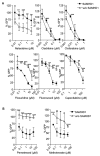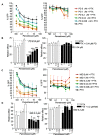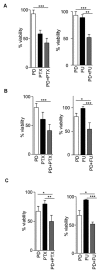Pharmacological Modulation of SAMHD1 Activity by CDK4/6 Inhibitors Improves Anticancer Therapy
- PMID: 32197329
- PMCID: PMC7140116
- DOI: 10.3390/cancers12030713
Pharmacological Modulation of SAMHD1 Activity by CDK4/6 Inhibitors Improves Anticancer Therapy
Erratum in
-
Erratum: Castellví, M. et al. Pharmacological Modulation of SAMHD1 Activity by CDK4/6 Inhibitors Improves Anticancer Therapy. Cancers 2020, 12, 713.Cancers (Basel). 2020 Jun 29;12(7):1728. doi: 10.3390/cancers12071728. Cancers (Basel). 2020. PMID: 32610575 Free PMC article.
Abstract
Sterile alpha motif and histidine-aspartic acid domain-containing protein 1 (SAMHD1) is a dNTP triphosphohydrolase involved in the regulation of the intracellular dNTP pool, linked to viral restriction, cancer development and autoimmune disorders. SAMHD1 function is regulated by phosphorylation through a mechanism controlled by cyclin-dependent kinases and tightly linked to cell cycle progression. Recently, SAMHD1 has been shown to decrease the efficacy of nucleotide analogs used as chemotherapeutic drugs. Here, we demonstrate that SAMHD1 can enhance or decrease the efficacy of various classes of anticancer drug, including nucleotide analogues, but also anti-folate drugs and CDK inhibitors. Importantly, we show that selective CDK4/6 inhibitors are pharmacological activators of SAMHD1 that act by inhibiting its inactivation by phosphorylation. Combinations of a CDK4/6 inhibitor with nucleoside or folate antimetabolites potently enhanced drug efficacy, resulting in highly synergic drug combinations (CI < 0.04). Mechanistic analyses reveal that cell cycle-controlled modulation of SAMHD1 function is the central process explaining changes in anticancer drug efficacy, therefore providing functional proof of the potential of CDK4/6 inhibitors as a new class of adjuvants to boost chemotherapeutic regimens. The evaluation of SAMHD1 expression in cancer tissues allowed for the identification of cancer types that would benefit from the pharmacological modulation of SAMHD1 function. In conclusion, these results indicate that the modulation of SAMHD1 function may represent a promising strategy for the improvement of current antimetabolite-based treatments.
Keywords: CDK4/6; HIV; SAMHD1; antimetabolite; cancer; pemetrexed.
Conflict of interest statement
The authors declare no conflict of interest.
Figures







Similar articles
-
A Cyclin-Binding Motif in Human SAMHD1 Is Required for Its HIV-1 Restriction, dNTPase Activity, Tetramer Formation, and Efficient Phosphorylation.J Virol. 2018 Feb 26;92(6):e01787-17. doi: 10.1128/JVI.01787-17. Print 2018 Mar 15. J Virol. 2018. PMID: 29321329 Free PMC article.
-
Palbociclib, a selective inhibitor of cyclin-dependent kinase4/6, blocks HIV-1 reverse transcription through the control of sterile α motif and HD domain-containing protein-1 (SAMHD1) activity.AIDS. 2014 Sep 24;28(15):2213-22. doi: 10.1097/QAD.0000000000000399. AIDS. 2014. PMID: 25036183
-
Inhibition of herpes simplex virus type 1 by the CDK6 inhibitor PD-0332991 (palbociclib) through the control of SAMHD1.J Antimicrob Chemother. 2016 Feb;71(2):387-94. doi: 10.1093/jac/dkv363. Epub 2015 Nov 4. J Antimicrob Chemother. 2016. PMID: 26542306 Free PMC article.
-
Targeting SAMHD1: To overcome multiple anti-cancer drugs resistance in hematological malignancies.Genes Dis. 2022 Jun 26;10(3):891-900. doi: 10.1016/j.gendis.2022.06.001. eCollection 2023 May. Genes Dis. 2022. PMID: 37396510 Free PMC article. Review.
-
Dual roles of SAMHD1 in tumor development and chemoresistance to anticancer drugs.Oncol Lett. 2021 Jun;21(6):451. doi: 10.3892/ol.2021.12712. Epub 2021 Apr 8. Oncol Lett. 2021. PMID: 33907561 Free PMC article. Review.
Cited by
-
Activation of STING by SAMHD1 Deficiency Promotes PANoptosis and Enhances Efficacy of PD-L1 Blockade in Diffuse Large B-cell Lymphoma.Int J Biol Sci. 2023 Aug 28;19(14):4627-4643. doi: 10.7150/ijbs.85236. eCollection 2023. Int J Biol Sci. 2023. PMID: 37781035 Free PMC article.
-
Nucleoside Analog 2',3'-Isopropylidene-5-Iodouridine as Novel Efficient Inhibitor of HIV-1.Pharmaceutics. 2023 Sep 27;15(10):2389. doi: 10.3390/pharmaceutics15102389. Pharmaceutics. 2023. PMID: 37896149 Free PMC article.
-
Modulation of DNA Damage Response by SAM and HD Domain Containing Deoxynucleoside Triphosphate Triphosphohydrolase (SAMHD1) Determines Prognosis and Treatment Efficacy in Different Solid Tumor Types.Cancers (Basel). 2022 Jan 27;14(3):641. doi: 10.3390/cancers14030641. Cancers (Basel). 2022. PMID: 35158911 Free PMC article.
-
Identification and evaluation of small-molecule inhibitors against the dNTPase SAMHD1 via a comprehensive screening funnel.iScience. 2024 Jan 13;27(2):108907. doi: 10.1016/j.isci.2024.108907. eCollection 2024 Feb 16. iScience. 2024. PMID: 38318365 Free PMC article.
-
Erratum: Castellví, M. et al. Pharmacological Modulation of SAMHD1 Activity by CDK4/6 Inhibitors Improves Anticancer Therapy. Cancers 2020, 12, 713.Cancers (Basel). 2020 Jun 29;12(7):1728. doi: 10.3390/cancers12071728. Cancers (Basel). 2020. PMID: 32610575 Free PMC article.
References
-
- Franzolin E., Pontarin G., Rampazzo C., Miazzi C., Ferraro P., Palumbo E., Reichard P., Bianchi V. The deoxynucleotide triphosphohydrolase SAMHD1 is a major regulator of DNA precursor pools in mammalian cells. Proc. Natl. Acad. Sci. USA. 2013;110:14272–14277. doi: 10.1073/pnas.1312033110. - DOI - PMC - PubMed
-
- Rice G.I., Bond J., Asipu A., Brunette R.L., Manfield I.W., Carr I.M., Fuller J.C., Jackson R.M., Lamb T., Briggs T.A., et al. Mutations involved in Aicardi-Goutières syndrome implicate SAMHD1 as regulator of the innate immune response. Nat. Genet. 2009;41:829–832. doi: 10.1038/ng.373. - DOI - PMC - PubMed
-
- Clifford R., Louis T., Robbe P., Ackroyd S., Burns A., Timbs A.T., Wright Colopy G., Dreau H., Sigaux F., Judde J.G., et al. SAMHD1 is mutated recurrently in chronic lymphocytic leukemia and is involved in response to DNA damage. Blood. 2014;123:1021–1031. doi: 10.1182/blood-2013-04-490847. - DOI - PMC - PubMed
-
- Rentoft M., Lindell K., Tran P., Chabes A.L., Buckland R.J., Watt D.L., Marjavaara L., Nilsson A.K., Melin B., Trygg J., et al. Heterozygous colon cancer-associated mutations of SAMHD1 have functional significance. Proc. Natl. Acad. Sci. USA. 2016;113:4723–4728. doi: 10.1073/pnas.1519128113. - DOI - PMC - PubMed
Grants and funding
LinkOut - more resources
Full Text Sources
Research Materials
Miscellaneous

